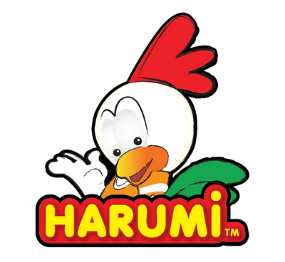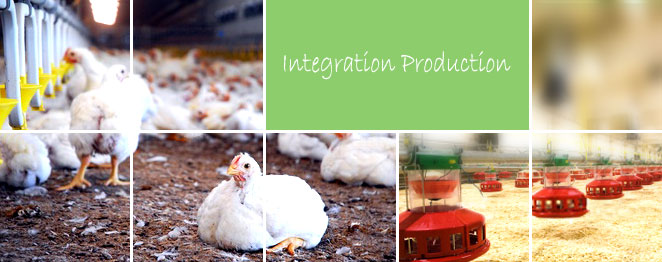|
|
 |
The chicken production chain starts at specialised breeding units which provide the foundations for ultimate meat quality. Specialists select breeds with the desired properties and cross them with one another. Very careful selection ensures we obtain chickens of the quality demanded by our customers.
HARUMi collaborates closely with international breeding company such as Arbor Acres, Cobb & Ross. They are all leading in breeding Grand Parents & Parents Stock sector. These specialists work with high-quality gene technology and combine this with their practical knowledge and experience. The correct selection of genetic material can result in different animals, each with their own characteristics as regards weight, tenderness or colour of the meat.
The company has a stringent biosafety programme which prevents undesirable crosses. At HARUMi feedback data collected and recorded in the chain. These practical data help the breeding unit to work in the best way at all times.
At HARUMi there are 100,000 parent birds producing 10 million chicks a year in which uniformity is of great importance. These birds are farmed on what are known as reproduction units where the hens and cocks are crossed. The hens lay their eggs but no longer hatch them out themselves. The eggs are rolled away so that the chicken cannot sit on them.
The fertilised eggs selected are hatched out at commercial hatcheries.
From there the day-old chicks go to the poultry farms for the final stage. |
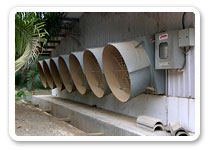 |
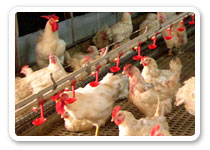 |
|
| Top |
| |
| |
 |
The hatching process
Once the eggs have arrived at the hatchery, they remain in the incubator for 18-21 days. The chicks live in the egg during this period, feeding on the yolk and the white. Egg white contains a natural bactericide. The membranes and the eggshell keep diseases out. Eggshells have ten thousand tiny holes which allow oxygen into the egg and water to evaporate from it. On the 18th day the eggs go to the inspection device that examines each egg automatically and records whether or not a chick is growing in it. All eggs containing a chick then proceed to the hatching machines. On the 20th day the chicks will have started to cheep in the eggs and on the 21st day they will be born. They will be dried out and downy after 2 hours.
The newborn chicks are placed on a sorting conveyor and selected by hand. They are taken via a counting conveyor to special chick bins and the dispatch room. There, at a constant temperature and with sufficient fresh air, they await transport to the poultry farms. They are loaded rapidly and skilfully into modern conditioned lorries. Once the chicks have left, the entire hatchery is cleaned and disinfected.
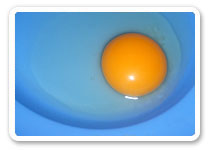 |
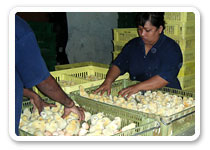 |
Hygiene
Hygiene is of the utmost importance during the incubation and hatching process. The eggs delivered must be completely clean and similarly, the incubation and hatching machines also have to be cleaned properly in order to prevent transmission of pathogens. Hatcheries take samples continuously from all risk areas in order to keep an eye on hygiene. They are checked for the presence of salmonella, among other things.
Traceability
The ability to trace eggs and chicks is important. In order to be able to safeguard food safety, we must be aware of the previous history of a product or bird. Every hatching egg has a unique number that is linked to the reproduction farm. Each transport vehicle is given a label stating the number of the reproduction unit and the production date. To this unique egg number, data on placement in the incubator and the hatching date for the egg are subsequently added. All the data are recorded and in turn linked to data on transport to the poultry farm and the shed in which the day-old chicks will be housed. This enables us to pinpoint the location of any problem area at any time.
Scheduling
Accurate matching of production to sales is one of the major HARUMi benefits, not only in terms of required quantities but also in terms of the desired meat quality.
The entire process is governed by HARUMi scheduling. It sets the date on which the hatching eggs are put in the incubators and which eggs will be placed in which Incubators. HARUMi also determines which poultry farm will receive the assigned pairs of day-old chicks.
Human work
Although many activities in the hatchery are automated, skilled and well motivated operators are still required in order to carry out additional checks and to fine-tune the process.
Expert, hands-on attention still plays an important role in inspecting the eggs, picking out unfertilised eggs, checking temperatures and processes and maintaining constant hygiene standards. This method of working guarantees product hygiene, traceability and safety.
|
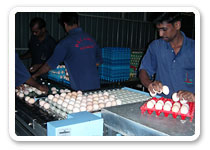 |
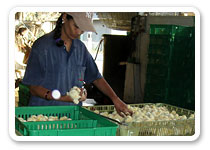 |
|
| Top |
| |
| |
 |
HARUMi works in collaboration with permanent partner hatcheries. This means that we do not own the hatcheries ourselves, instead we enjoy a permanent and long-term relationship with them. The farmers who operate the hatcheries are independent and frequently family businesses. HARUMi select their partner hatcheries with utmost care. This collaboration is based on fixed contracts giving rise to healthy business relationships. All HARUMi partner farms work in accordance with the IKB [( integrale ketenbeheersing – Integrated Chain Control) scheme, HACCP and the Code of Practice. This working practice ensures that quality is safeguarded and that day-old chicks are supplied which meet the requirements of our customers.
HARUMi needs tens of millions of breeding eggs a year. The hatcheries receive the eggs from special reproduction farms where parent birds lay the eggs. Chickens no longer hatch the eggs out themselves in a hatchery, instead special incubators handle this task for them.
Just as with the hatcheries, HARUMi also has a permanent relationship with the reproduction farms in the production chain. This working method guarantees a high degree of commitment to the results and highly effective control of quality and safety.
|
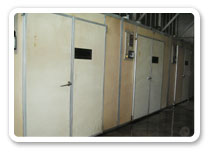 |
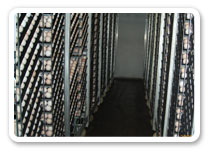 |
|
| Top |
| |
| |
 |
The day they are hatched, the day-old chicks are taken to the poultry farm. This is done with great care. A good start is of prime importance to the chicks and during the first few days they are less able to keep their body temperature at the right level. For this reason the poultry farmer will ensure that the floor and ambient temperatures are correct as well as providing proper ventilation. Feed is also very important at the early stages, since the chicks need to build up good resistance and the digestive system has yet to develop. HARUMi has developed special feed for this period.
The poultry farmer will ensure that the birds have sufficient easily accessible feed and clean drinking water, as well as the right lighting in the shed. In this way he will keep the chicks active and healthy, the birds will grow well but not too fast and they will build up a good immune system and a properly functioning digestive system. The chicks will be fully grown after approximately 6 weeks, at which time, after being checked by the veterinary surgeon, they will be sent for slaughter.
|
|
| Top |
| |
| |
 |
Farming chickens for meat is a specialist trade in poultry farming. It came about after World War II. Poultry farmers receive day-old chicks and rear them until they are ready for slaughter. At that point the chickens weigh approximately 2400 grams. Approximately 1700 grams of chicken meat will be left over after slaughter. The production chain is made up of a number of highly specialised links which operate in a carefully matched process. At HARUMi all these stages of production come together as a single unit: an integrated poultry facility.
|
|
| Top |
| |
| |
 |
Once the birds arrive at the abattoir, they are carefully unloaded and placed in the delivery hall. The temperature, humidity and ventilation here are comparable to those in the shed and in the lorry. Since calm is important, the delivery hall is bathed in restful blue light and the birds are left standing for approximately one hour there.
We pay a great deal of attention to the initial stages of processing, where preventing stress is the number one priority. This is kinder to the birds, it benefits meat quality and is also bacteriologically superior.
The slaughter process is quick and professional. The operators who carry out this work are specialists in their trade. At HARUMi, the birds are stunned electrically which renders them rapidly unconscious, after which the birds are painlessly slaughtered. The methods of stunning and killing meet the requirements stipulated as regards animal welfare, meat quality and Halal requirement.
The slaughter process downstream is largely automated. Handling has been reduced to a minimum and downstream processing of the chicken meat has been increasingly automated. This method of working raises bacteriological quality to the highest level and offers substantial benefits in terms of storage life.
The same applies to supply, removal and processing of by-products. |
|
| Top |
| |
| |
 |
Distribution
Maintaining the cold chain in the distribution of chicken and chicken products is a basic condition for microbial quality. It is only through proper procedures and correct temperatures that products will retain their top quality.
The maximum temperature for processing chicken is 7°C. Loading chicken and chicken products also takes place in a conditioned (cold) environment. Finally, HARUMi goods vehicles are also refrigerated. All necessary steps are taken to keep the core temperature of the chicken meat in the cold chain at 4°C.
The refrigeration system in the goods vehicles is operational before and throughout the journey. The driver can monitor the temperature from his cab and adjust it if necessary.
Our closed cold chain ensures that at no point during transit does the meat come into contact with warm outside air. This enables us to maintain optimum microbial quality in our chicken and chicken products.
Fresh daily and ‘just in time’
We want to deliver our products just in time to our customers, the supermarkets, the industry and food service. For our companies, every day is a new challenge to deliver the right chicken or chicken products, entirely fresh, to the stipulated specifications, in the right packaging and at the right time. This requires sophisticated planning and procedures, a flexible attitude and excellent organisational ability from all our companies. The fact that we achieve this, time and time again, is thanks to our highly professional employees and high-quality information and communication systems.
Gtrace+™ right up to the customer
The data from our Gtrace+™ programme are still linked to the products that ship from our company, even in transit. If necessary or if they so desire, customers can look up any Gtrace+™ information on the meat they receive.
|
|
| Top |
| |
| |
 |
Chickens naturally eat food of vegetable as well as animal origin. As well as eating seeds, leaves and grains, they also eat caterpillars, worms and insects. In poultry farming, a chicken's diet is mostly vegetarian and includes grains, maize, soya beans, oil and minerals.
The diet of the birds in the HARUMi chain is closely matched to their needs at that particular stage in their lives. Each group of chickens is given feed made up of special ingredients. A day-old chick will eat differently to a laying hen or an adult chicken. The feed is also matched to the purpose for which the chicken is being farmed, such as breeding eggs or fillet production.
|
|
| Top |
|
